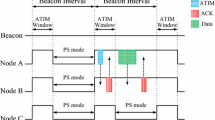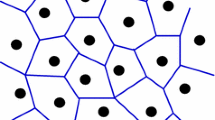Abstract
This paper investigates the power mode management problem for an IEEE 802.11-based mobile ad hoc network (MANET) that allows mobile hosts to tune to the power-saving (PS) mode. There are two major issues that need to be addressed in this problem: (a) wakeup prediction and (b) neighbor discovery. The former is to deliver buffered packets to a PS host at the right time when its radio is turned on. The latter is to monitor the environment change under a mobile environment. One costly, and not scalable, solution is to time-synchronize all hosts. Another possibility is to design asynchronous protocols as proposed by Tseng et al. in [25]. In this paper, we adopt the latter approach and correlate this problem to the quorum system concept. We identify a rotation closure property for quorum systems. It is shown that any quorum system that satisfies this property can be translated to an asynchronous power-saving protocol for MANETs. Thus, the result bridges the classical quorum system design problem in the area of distributed systems to the power mode management problem in the area of mobile ad hoc networks. We derive a lower bound for quorum sizes for any quorum system that satisfies the rotation closure property. We identify a group of quorum systems that are optimal or near optimal in terms of quorum sizes, which can be translated to efficient asynchronous power-saving protocols. We also propose a new e-torus quorum system, which can be translated to an adaptive protocol that allows designers to trade hosts' neighbor sensibility for power efficiency. Simulation experiments are conducted to evaluate and compare the proposed protocols.
Similar content being viewed by others
References
B. Chen, K. Jamieson, H. Balakrishnan and R. Morris, Span: An energy-efficient coordination algorithm for topology maintenance in ad hoc wireless networks, in: Proc. of the International Conference on Mobile Computing and Networking (2001) pp. 85–96.
C.F. Chiasserini and R.R. Rao, A distributed power management policy for wireless ad hoc networks, in: Proc. of IEEE Wireless Communication and Networking Conference (2000) pp. 1209–1213.
C.J. Colbourn and E.J.H. Dinitz, The CRC Handbook of Combinatorial Designs (CRC Press, 1996).
C.J. Colbourn, J.H. Dinitz and D.R. Stinson, Quorum systems constructed from combinatorial designs, Information and Computation (2001) 160–173.
L.M. Feeney and M. Nilsson, Investigating the energy consumption of wireless network interface in an ad hoc networking environment, in: IEEE INFOCOM (2001) pp. 1548–1557.
J. Gomez, A.T. Campbell, M. Naghshineh and C. Bisdikian, A distributed contention control mechanism for power saving in random-access ad-hoc wireless local area networks, in: Proc. of IEEE International Workshop on Mobile Multimedia Communications (1999) pp. 114–123.
J.C. Haartsen, The Bluetooth radio system, IEEE Personal Communications (February 2000) 28–36.
L. Hu, Topology control for multihop packet radio networks, IEEE Transactions on Communications 41 (October 1993) 1474–1481. ]
C.F. Huang, Y.C. Tseng, S.L. Wu and J.P. Sheu, Increasing the through-put of multihop packet radio networks with power adjustment, in: Proc. of International Conference on Computer, Communication, and Networks (2001).
E.-S. Jung and N.H. Vaidya, An energy Efficient MAC protocol for wireless LANs, in: Proc. of INFOCOM 2002 (2002).
LAN MAN Standards Committee of the IEEE Computer Society, IEEE Std 802.11–1999, Wireless LAN Medium Access Control (MAC) and Physical Layer (PHY) specifications (IEEE, 1999).
S.D. Lang and L.J. Mao, A torus quorum protocol for distributed mutual exclusion, in: Proc. of the 10th Internat. Conference on Parallel and Distributed Computing and Systems (1998) pp. 635–638.
J.R. Lorch and A.J. Smith, Software strategies for portable computer energy management, IEEE Personal Communications (June 1998) 60–73.
W.S. Luk and T.T. Wong, Two new quorum based algorithms for distributed mutual exclusion, in: Proc. of International Conference on Distributed Computing Systems (1997) pp. 100–106.
M. Maekawa, A √N algorithm for mutual exclusion in decentralized systems, ACM Transactions on Computer Systems (1985) 145–159.
C.E. Perkins and E.M. Belding-Royer, Ad-hoc on-demand distance vector routing, in: Proc. of IEEE Workshop on Mobile Computing Systems and Applications (1999) pp. 90–100.
R. Ramanathan and R. Rosales-Hain, Topology control of multihop wireless networks using transmit power adjustment, in: Proc. of IEEE INFOCOM (2000) pp. 404–413.
J.H. Ryu and D.H. Cho, A new routing scheme concerning power-saving in mobile ad-hoc networks, in: Proc. of IEEE International Conference on Communications, Vol. 3 (2000) pp. 1719–1722.
J.H. Ryu, S. Song and D.H. Cho, A power-saving multicast routing scheme in 2-tier hierarchical mobile ad-hoc networks, in: Proc. of IEEE Vehicular Technology Conference, Vol. 4 (2000) pp. 1974–1978.
A.K. Salkintzis and C. Chamzas, An in-band power-saving protocol for mobile data networks, IEEE Transactions on Communications 46 (September 1998) 1194–1205.
E. Shih, P. Bahl and M.J. Sinclair, Wake on wireless: An event driven energy saving strategy for battery operated devices, in: Proc. of MOBICOM 2002 (2002).
T. Simunic, H. Vikalo, P. Glynn and G.D. Micheli, Energy efficient design of portable wireless systems, in: Proc. of the International Symposium on Low Power Electronics and Design (2000) pp. 49–54.
S. Singh and C.S. Raghavendra, Power efficient MAC protocol for multihop radio networks, in: Proc. of IEEE International Personal, Indoor and Mobile Radio Communications Conference (1998) pp. 153–157.
S. Singh, M. Woo and C.S. Raghavendra, Power-aware routing in mobile ad hoc networks, in: Proc. of the International Conference on Mobile Computing and Networking (1998) pp. 181–190.
Y.C. Tseng, C.S. Hsu and T.Y. Hsieh, Power-saving protocols for IEEE 802.11-based multi-hop ad hoc networks, in: Proc. of IEEE INFOCOM (2002).
R. Wattenhofer, L. Li, P. Bahl and Y.M. Wang, Distributed topology control for power efficient operation in multihop wireless ad hoc networks, in: Proc. of IEEE INFOCOM (2001) pp. 1388–1397.
H. Woesner, J.P. Ebert, M. Schlager and A. Wolisz, Power-saving mechanisms in emerging standards for wireless LANs: the MAC level perspective, IEEE Personal Communications (June 1998) 40–48.
S.L. Wu, Y.C. Tseng and J.P. Sheu, Intelligent medium access for mobile ad hoc networks with busy tones and power control, IEEE Journal on Selected Areas in Communications 18 (September 2000) 1647–1657.
Y. Xu, J. Heidemann and D. Estrin, Geography-informed energy conservation for ad hoc routing, in: Proc. of the International Conference on Mobile Computing and Networking (2001) pp. 70–84.
Author information
Authors and Affiliations
Rights and permissions
About this article
Cite this article
Jiang, JR., Tseng, YC., Hsu, CS. et al. Quorum-Based Asynchronous Power-Saving Protocols for IEEE 802.11 Ad Hoc Networks. Mobile Networks and Applications 10, 169–181 (2005). https://doi.org/10.1023/B:MONE.0000048553.45798.5e
Issue Date:
DOI: https://doi.org/10.1023/B:MONE.0000048553.45798.5e




